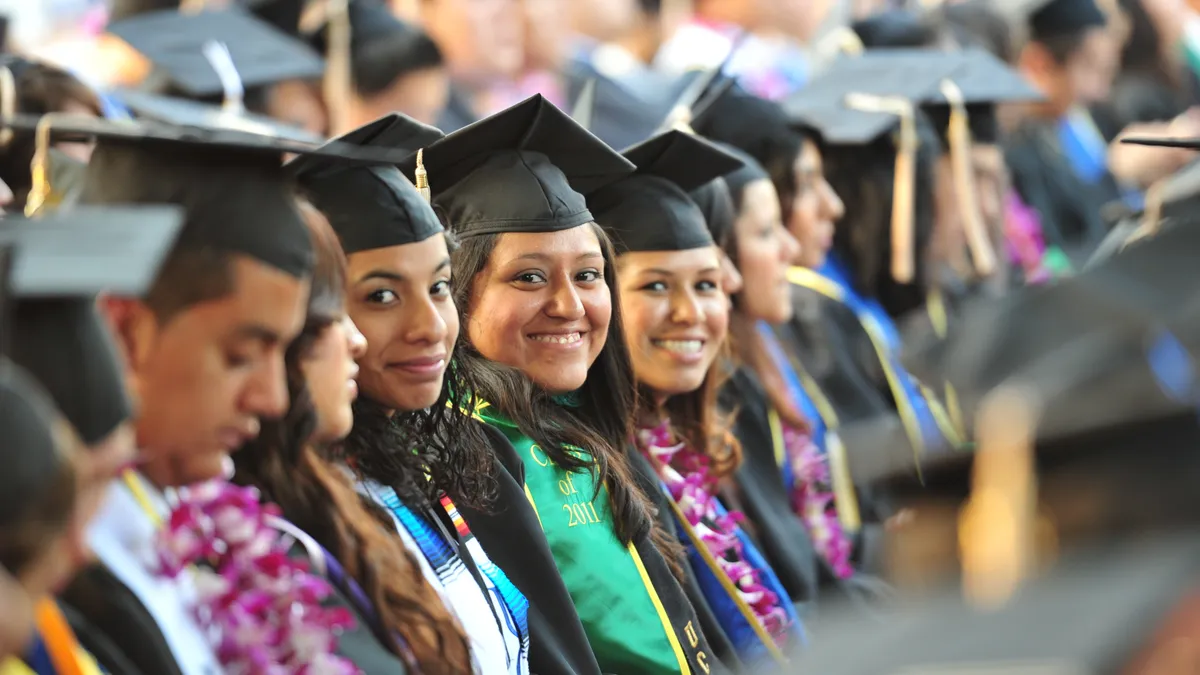Dive Brief:
- A new report from UnidosUS highlights that the share of Latino students aged 18 to 24 years old — of which 75% are first-generation — going to college has increased from 24% to 39% over the last decade, but barriers to enrollment and completion remain as they work to learn how to navigate the American college system from scratch.
- The report showcases a through-line of major barriers from interviews conducted to include the fact that many of these first-generation students "were learning about these processes [like financial aid] alongside their parents, without the benefit of prior family experience," and many of these students were struggling with "heavy workloads and balancing a range of obligations," like "culture shock" and "working one or more part-time jobs," or perhaps even worrying about their Deferred Action for Childhood Arrivals status. Many participants also reported feeling encouraged by their families to attend school and benefiting from "high school counselors and nonprofit college counseling programs."
- But while over half of interview participants reported taking on student loans, "the majority of participants said they were doing as well or better," than their parents — demonstrating that these students value the "upward mobility" and "financial benefits" associated with education, but felt the costs and cultural barriers were challenging, and attainment gaps still remain. In 2016, the graduation rate for Latinos in four-year programs was 54% compared to 63% for their white peers, and 19% versus 25% for two-year institutions.
Dive Insight:
There's a lot of discussion among policymakers and higher education leaders around what needs to be done in order to address the needs of and types of barriers underrepresented students face. But first, it's about recognizing that even within the same classification, these students are not a monolithic population and their needs vary greatly from one group to the next.
Madeline Pumariega, chancellor of the Florida College System explained at a recent Capitol Hill event on closing the graduation gap for Latino students that addressing the individual needs of students with different backgrounds — even though they often get classified as one demographic group — is actually of of the most challenging parts of trying to create pathways for underserved students coming from multiple diverse backgrounds.
"You really can't paint Florida with one brush. You have South Florida [and this region] is very different [...] and the migration there tends to be a different Hispanic migration than around the country [...] very different than maybe the Texas migration," said Pumariega. "For one, it's about acknowledging you can't paint Latinos with one brush in terms of where they come from and what their socioeconomic backgrounds are."
"But here's what we know about student success, we know that if you give students a caring adult, a guided pathway, you provide financial resources, and you find ways to engage them on campus, they stay and they graduate. And so how do we take that to scale?" she added, noting that Florida still has a lot to do on this front, in terms of disaggregating the data and understanding what's scalable given the unique backgrounds of students. Carlos Santiago, commissioner of the Massachusetts Department of Higher Education, added that with first-generation students, the support structures are often different and require leaders to go into communities to interact with students and offer guidance even before they come to college.
"Even in Massachusetts, which has the highest high school graduation rates [...] there's a dirty little secret which is that 30% of those students that graduate from high schools successfully and pass all those exams have to remediate when they come to college," he said.







